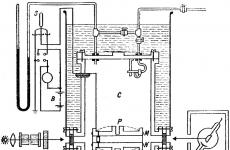Ventilation of private houses and cottages. Calculation of supply and exhaust ventilation in a cottage. Natural ventilation of the cottage
Types of heating, ventilation and air conditioning (HVAC) systems of a cottage, a frequent country house
Choosing a specific type heating, ventilation and air conditioning (HVAC) systems depends on many factors: is there gas on the site or not, the desired air quality, the customer's financial capabilities, the availability of energy-efficient solutions.
We will reveal the main types of systems used by specialists Detail Engineering.
Type 1. High-temperature heating of a cottage, a private country house, natural ventilation, wall split air conditioning
Heating, ventilation and air conditioning project for the cottage. High temperature heating by a radiator system.
Heating system cottage, private country house works at the expense of a gas boiler, the type of wiring is collector. Pipes made of cross-linked polyethylene of a high degree of cross-linking Pex -a. Radiators or convectors are provided as heating devices. The underfloor heating system is located in the bathrooms and kitchen. Ventilation system natural with valves installed on the windows. Each room of the cottage is equipped with a humidifier and purifier.
This solution is the simplest and most economical. Capital costs are minimal. Moreover, it will be warm in winter and cool in summer.
Type 2. High-temperature heating, supply and exhaust ventilation, duct air conditioning of a cottage, a private country house
 Heating, ventilation and air conditioning project for the cottage. Supply and exhaust system with fresh air admixture into ducted air conditioners.
Heating, ventilation and air conditioning project for the cottage. Supply and exhaust system with fresh air admixture into ducted air conditioners.
Heating of a cottage, a private country house a gas boiler with the ability to regulate individual circuits: heat supply to ventilation, warm water floor, pool. Design radiators or convectors can be used as heating devices. Ventilation system- mechanical supply and exhaust with central humidification and good filtration. Conditioning cotteja or private country house- channel based on multisplit or VRV systems. Underfloor heating is provided in the bathrooms and kitchen.
Duct air conditioning can be combined with supply ventilation. Such a solution will significantly increase the level of comfort and have a beneficial effect on the design, because in the serviced premises, with proper design and installation ventilation and air conditioning systems (HVAC) of the cottage, private country house the noise level will drop to 20-25 dB. The cost of duct air conditioning, mechanical supply and exhaust ventilation is higher than that of wall-mounted multisplit systems and natural. Also, the system allows you to regulate the temperature and humidity of the premises, to receive air of a higher quality.
Type 3. Hybrid heating, supply and exhaust ventilation, passive air conditioning of a cottage, a private country house
 Heating, ventilation and air conditioning project for the cottage. Fan coil passive cooling system
Heating, ventilation and air conditioning project for the cottage. Fan coil passive cooling system
To improve efficiency and reliability heating systems of a cottage, a private country house the installation of two boilers is envisaged: a conventional high-temperature one and a condensing one. The high temperature boiler serves ventilation system private country house, ducted fan coil units, swimming pool. A low-temperature condensing boiler is most effective at low temperatures of the coolant; with the help of an underfloor heating system, we shut off half of the heat loss at home. Ventilation - mechanical supply and exhaust with a high degree of filtration and central humidification. Air conditioning system of a cottage, a private country house- due to cold water from the well. The cost of this type is approximately the same as the previous one, however design and installation this type is more labor intensive. When air conditioning a large area, the system benefits from both capital and maintenance costs.
Type 4. Energy efficient heating of a cottage, a private country house. Ventilation with recuperation. Air conditioning - duct fan coil units
 Heating, ventilation and air conditioning of the cottage. Type 4. Energy efficient system.
Heating, ventilation and air conditioning of the cottage. Type 4. Energy efficient system.
If there is no gas on the site, then the optimal design solution for heating, ventilation and air conditioning (HVAC) systems cottage, private country house is the installation of a geothermal heat pump. Warm floors with a minimum installation pitch cover part of the heat loss of the room. The rest of the heat loss is assimilated using 2- or 4-pipe duct fan coil units. Air supply and intake from the serviced premises is carried out through the air duct network. Temperature control of the cottage is per room, humidity is centralized. Ventilation - supply and exhaust with heat and moisture recovery. This type heating, ventilation and air conditioning systems cottage, private country house is energy efficient and is very common in Epropus. In Russia, with low gas prices, operating costs are approximately equal, therefore, the main advantages over traditional heating, ventilation and air conditioning systems are: safety, unity of heating, ventilation and air conditioning, and the absence of radiators.
Features of heating, ventilation and air conditioning (HVAC) for a cottage, a private country house
When designing engineering systems for heating, ventilation and air conditioning of a cottage, a private country house, it is important to take into account several features:
- noise pollution;
From the point of view of noise for a cottage, a private country house, a single HVAC system is optimal, where fresh air is mixed into the ducted air conditioning system. By installing sound attenuators after the supply unit, at the supply and intake of ducted air conditioners, noise pollution can be minimized.
- minimal impact on design;
For a private country house, the presence of only two, and sometimes one, decorative lattice in the premises, minimizing the sinks has a beneficial effect on the design.
- minimum power consumption;
- high level of automation and ease of use.
DetaiL EngineenG develops projects, supplies equipment and materials, installs and commissions systems: heating, ventilation, air conditioning, water supply and sewerage for cottages, private country houses of varying complexity, taking into account the individual characteristics of the object and the personal wishes of the customer.
The ventilation of the cottage still has similar features, since the principle of operation of the ventilation systems is essentially the same. First, the ventilation of cottages is the health of the residents. Renewal of the air in the house has a positive effect on the human condition.
Often headaches, fatigue, and sometimes dizziness become the consequences of a lack of oxygen flow, which gets inside the house not only through open windows and entrance doors, but also through ventilation.
Secondly, high-quality ventilation of cottages is an opportunity to avoid financial waste due to decay of the wooden structures of the house, the presence of mold, mildew and other negative effects of humid air.
At the moment, companies offer several options for ventilation systems for cottages. Some can be considered optimal, others are affordable, and still others are of better quality. However, they all boil down to one thing - to carry out air exchange in the cottage and create the most favorable conditions.
Variety of options
High-quality ventilation of cottages can be considered only when its planning and design begins simultaneously with the planning and design of the entire house. A cottage ventilation project always depends on the number of rooms and their purpose.
Forced or natural air exchange is of course up to the owner. Natural air exchange does not imply many costs, easier installation and less time spent on installation. But considering the rather abnormally high summer temperatures, it is better to look towards the combination of air conditioning and ventilation at the same time.
Also, a cottage is usually a large building with rooms of different functionality - a pool, a basement, a gym, an office and traditional bathrooms, bathrooms, kitchens, bedrooms.

The most effective ventilation of cottages is one of the following options:
- Exhaust ventilation of cottages.
The supply of air is of a natural type, and its extraction is forced. This is the most common option, where ventilation of cottages allows you to maintain the necessary oxygen balance in the premises. Exhaust ducts are usually installed in kitchens, bathrooms, toilets, all utility rooms and must be fitted with adjustable dampers. Manual control is often necessary to improve the performance of the ventilation system.
The inflow of fresh portions of air is carried out through the supply wall and / or window channels - there is absolutely no noise. But such valves need to be equipped with filters to avoid dustiness in the premises.
The exhaust air will be removed through a system of exhaust fans, which can be installed in the attic, utility room or any convenient location. The low noise of the devices allows installation in any suitable place. By the way, the issue of ventilation in the attic can also be solved if equipment is installed on it.
- Supply and exhaust ventilation of cottages.
This option implies, in some cases, the recovery of exhaust air heat, which can be used for your own purposes. The difference from the first option lies in the unity of the installation, when the inflow and outflow of air is performed by one single system. This option is structurally more complex, but has a slightly greater advantage and is considered a better option.

Air inflow comes from the street, simultaneous cleaning of impurities and odors is performed, and heating is also possible in cold weather. Then the air enters all the necessary rooms and premises through the ceiling shades. Air heating is especially valuable for the comfort of residents. For this, as a rule, a plate-type recuperator is used.
- Combination of ventilation and air conditioning systems.
A typical example when the ventilation of cottages is air conditioning with a split system with supply ventilation and natural exhaust. Air conditioning is carried out using two units: an external one, which is installed on the technical floor or outside the house, and an internal one, which will be located indoors or in the attic (there are different models). This option is considered to be as comfortable as possible due to its versatility. Ventilation of cottages in this way provides maximum comfort for those living in the house.
Things to Consider
At the stage of designing a cottage or during the start of construction, you should definitely take care of the following:
- The project of communications designed for the ventilation system.
- Power reserve for fans and (if any) air conditioner.
- Ventilation shafts, which should preferably be two.
- Place for ventilation units.
On your own or with the help of professionals
Ventilation of the cottage is quite feasible on your own. All the more so if you have the relevant experience and knowledge acquired in the course of repeated similar works. When a beginner gets down to business, it is better to carefully study the theoretical part. This is especially important when the cottage has already been built, since it is possible to talk about quality only with the simultaneous design of the ventilation system and the construction plan itself.
The ventilation of the pool in the cottage is the most crucial moment, because in addition to air exchange, you need to control the humidity in this room. It is also important to study materials, properties of air, to know the aerodynamics of the movement of air masses.
The ventilation of the cottage will only be effective when the following general rules are observed:
- in cold weather, air exchange should not cool the premises.
- air exchange from the street should be carried out on an ongoing basis.
- the inflow of fresh air should be in all rooms without exception.
- odor contaminated or exhaust air must be removed quickly.
- ventilation of cottages should not have drafts.
We believe that FORUMHOUSE users will agree with the statement that a competent approach to the ventilation system is as follows - first of all, it is necessary to calculate the air exchange, then, based on these data, select the required duct cross-section. And only after that it is possible to draw up a ventilation scheme for the cottage, and determine the installation locations of ventilation equipment.
Types and features
According to the user our portal (nickname on the forumpetrovk, Moscow city) ventilation in the house can be divided into three types:
- Natural;
- Supply, or as it is also called, mechanical;
- Air handling unit with heat recovery.
petrovk:
- When designing a ventilation system, the following principle should be followed – the air in the house must be completely renewed in 1 hour. For my 200 m2 frame house, I settled on an air handling unit with heat recovery. The installation is selected based on the number of cubes of air in the house, I have 600, I took the installation for 700 cubic meters.
It should be remembered that a comfortable environment in the house is created not only due to the supply of fresh air, but also due to the speed of movement of air flows. Supply and exhaust ventilation, due to the presence of a fan in it, creates a greater air flow than natural ventilation.
When mechanical ventilation is in operation, the air velocity in the ventilation system averages 3-5 m3 / hour, and with natural ventilation, it is about 1 m3 / hour. Let's try to figure out if natural ventilation creates a more comfortable environment in the house. This question is not as simple as it sounds. Indeed, in order to pass the same volume of air through a mechanical and natural ventilation system, a different section of the ventilation duct is required. This means that the installation of natural ventilation will entail an increase in the channel cross-section, which is far from always possible from a technical or aesthetic point of view.
With any type of ventilation, no matter whether it is natural or mechanical, it is necessary to ensure the unhindered movement of air throughout the house.
 One of the options is to install doors with a transfer grille in the rooms, or leave a small gap between the door and the floor. For the correct organization of the air flow, it is necessary that the air intake is carried out in the cleanest room, living room or bedroom, and the output is carried out in the kitchen or in the bathroom.
One of the options is to install doors with a transfer grille in the rooms, or leave a small gap between the door and the floor. For the correct organization of the air flow, it is necessary that the air intake is carried out in the cleanest room, living room or bedroom, and the output is carried out in the kitchen or in the bathroom.
In the kitchen, above the stove, the hood should run in a separate channel. If the hood is forced, then the kitchen and bathroom can be combined with one ventilation duct. The diameter from inlet to outlet should not decrease. Due to the specifics of the kitchen hood, the air duct from it must be made round, galvanized and vertical, without knees. Do not use corrugated, aluminum or plastic ductwork.
Consultant of our forumElena Gorbunova(nickname on the forum Matilda ):
- Natural ventilation works with a differential pressure at the inlet and outlet. The inlet is an exhaust valve, it is installed in the ceiling of the room or in the wall under the ceiling. The exit is the top of the pipe. The drop starts at 10 meters. The pressure difference also depends on the temperature difference. It is better in winter and worse in summer.
The natural inflow is done above the heating devices, which are usually located under the windows. Or two meters above the floor.
The question often arises,
Is it possible to combine the ventilation ducts of the kitchen, bathroom and boiler room into a single system, then put a duct fan, and take everything out through the roof with one pipe?
User of our forum Vladimir(nickname on the forum Careless Angel ) believes that:
- In no case should you combine the hood with the sewer, then the whole house will stink like a toilet, regardless of whether an air duct is installed in front of the fan or after.

Also of great importance is the material from which the ventilation ducts are made for a private house. One of the best options is the use of spiral-wound galvanized air ducts. But with self-installation, developers massively use ventilation ducts made from a sewer pipe with a diameter of 110 mm.
Matilda
:

– Sewer pipes cannot be used. In general, plastic cannot be used for air ducts, unless these are special antistatic pipes. In this case, dust will stick to the walls. In addition, the sewer pipes have a small diameter. And the thrust directly depends on the diameter of the duct and the height difference. The difference in the cottages is small enough - this is not a high-rise building for you. This means that with a small diameter, there will be practically no thrust, especially in summer. And if you put a fan, then the sewer pipes will make a very unpleasant sound when the air moves.
Air ducts for ventilation for a private house - requirements and features

 For the ventilation system to work with maximum efficiency, it is necessary that the inner surface of the duct has minimal resistance to air movement. Let's see how to choose the right one v air ducts for ventilation of your home.
For the ventilation system to work with maximum efficiency, it is necessary that the inner surface of the duct has minimal resistance to air movement. Let's see how to choose the right one v air ducts for ventilation of your home.
Matilda :
- The main task
duct is to allow air to mix freely from the point of air intake to the point of its exit. And be safe from the point of view of ecology and fire safety. Any pressure loss strongly affects or negates the air exchange during natural ventilation. Pressure losses arise from an uneven surface of the duct, in horizontal sections, in elbows, tees, etc. With a rectangular air duct, losses are higher than with a round one, and dust accumulates in them well.

Flexible - the corrugated duct offers the highest air resistance. And it is best used when you need to make a turn or connect a kitchen hood to the ventilation duct.
Very often, developers, for various reasons, do not want to draw the outlet through the roof, preferring to lead the ventilation duct through the wall. It is not right.
Matilda
:

– You should never, under any circumstances, remove ventilation through the wall. Spoil the facade.
In a couple of years there will be a visible spot on the wall around the exit.
And thus, it is also pointless to bring out natural ventilation, since there will be absolutely no difference in height, and, accordingly, pressure.

If, with a forced ventilation system, all air ducts are connected by elbows and adapters with one vertical channel, then it is recommended to install an E190P fan on the roof.
To control this fan, a thyristor speed controller is installed in a convenient place. And the air ducts themselves are taken with a diameter of 125 mm.
On FORUMHOUSE you will find an article about, a lot of useful information, a fascinating discussionchoice And after reading our video, youyou will be able to clearly see how an integrated approach to the ventilation device allows not only to provide the house with fresh air, but also to save money.
Indoor ventilation is a collection of ducts, pipes and fans that create air circulation and improve its quality. There are different types of ventilation systems depending on the type of room. To establish a correct and effective system, it is necessary to draw up a competent professional project. Designing ventilation for a cottage is a responsible and complex process that is performed by specialized organizations. But if necessary, you can make the project yourself.
How to calculate air exchange in a private house
There must always be a continuous exchange of air in the room. The process is important both in cold and warm seasons.
First of all, this is necessary to maintain sanitary and hygienic standards, to clean the air from dust, dirt, high humidity. In a sealed room, a "conservation effect" occurs, and all microbes and bacteria multiply at an increased rate.
In addition, by means of air exchange, the process of cooling or heating the room can take place.
The peculiarities of the organization of air exchange in the premises are regulated by the Building Norms and Rules (SNiP).
Distinguish between norms for public buildings, apartment buildings, industrial buildings and general norms and requirements.
In residential premises, ventilation is:
- with natural air circulation;
- with mechanical (including heating function);
- mixed.
Oxygen enters the rooms through windows, vents, wall valves. Removal is usually done through hoods in kitchens, bathrooms, washrooms.
Air exchange rate:
- up to 30 m 3 / hour per 1 m 2, provided that there is less than 20 m 2 of area per person;
- from 30 m 3 / hour - if more than 20 m 2.
Air penetrates into kitchens in the same way as into living quarters. But the work of the stoves and the steam from cooking make it necessary to organize enhanced natural draft or install hoods.
Norms for the kitchen: from 60 to 100 m 3 / hour.
In bathrooms, air exchange should be from 25 m 3 / hour, since unpleasant odors and chemicals should be removed. In rooms where linen is washed and dried - from 90 m 3 / hour. Air enters through doors and door slits from adjacent rooms.
In office premises, air exchange is from 60 m 3 / hour per person.
The main requirements for the ventilation system in the room can be distinguished:
- full supply of fresh air;
- noiselessness;
- inflow and outflow;
- economical consumption of heat and electricity.
Air inflow into the room is carried out in the following ways.
- Through loose fences.
The process is called infiltration. It consists in the flow of air through walls, cracks in window frames and doorways.
- Airing.
It is produced by opening windows and doors in whole or in part. Depending on the latitude of exchange, the rate of complete air replacement in the room changes: from 3 to 80 minutes.
- Built-in infiltration valves.
They are special holes in the window frame through which air from the street enters. In the absence of such, special valves with a plug are used, which are placed either in the wall next to the window or above the radiator to obtain warm air.
- Forced ventilation.
We are talking about the use of fans, heaters, filters, noise-insulating elements.
The air exhaust system is of two types:
- natural,
- mechanical.
The natural system is used when there is no need to remove large volumes of air. Or when a ventilation shaft is provided in the building structure. Mechanical is used in bathrooms, bathrooms, kitchens, that is, where it is necessary to clean large air flows. To do this, use built-in hoods, electric fans.
 Organization of ventilation in a private house
Organization of ventilation in a private house
Before proceeding with the installation of ventilation in the house, it is necessary to study the advantages and disadvantages of various systems.
The advantages of the natural system include the following:
- installation of additional equipment is not required;
- no breakdowns, no need for maintenance;
- combination with an air conditioner.
The disadvantage is the inability to control and speed up the process, as well as the need for wind to function.
Mechanical system advantages:
- work does not depend on weather conditions;
- cleaning, heating, cooling air;
- control of the amount of processed air.
Disadvantages are high installation costs and the need for constant inspection and maintenance.
The choice of ventilation system will depend on whether the house is inertial or inertialess.
Inertia is the property of a house to maintain a given temperature for a certain time. The higher the degree of inertia, the longer the house remains warm when the heating is off. The inertialess house cools down almost immediately.
Inertial houses take a long time to warm up, as they accumulate and store heat. Therefore, in this case, it is better to use natural ventilation, since the circulation of air from the outside will not affect the rapid cooling or heating.

In inertialess houses, it is better to install a mechanical system, since it will be necessary to quickly either heat or cool the room.
In private houses, it should be borne in mind that the ventilation device for each individual type of room is different from each other.
In living rooms, it is important to ensure the flow of air by opening windows and vents, installing air valves or through slots. Outflow occurs through exhaust vents in bathrooms, bathrooms and kitchens.
In the kitchen, the inflow is provided by windows and adjacent rooms, the outflow is provided by built-in hoods. The same situation is with bathrooms, toilets, laundry and ironing rooms.
Home ventilation design involves the use of various types of equipment.

Ventilation and savings
The ventilation system must be correctly designed for each individual room, easy to operate and economical in terms of the use of funds and resources.
In the cold season, together with the ventilated air, a large amount of heat is displaced, which contributes to an increase in thermal energy consumption and increases the cost of utilities. Such a development as a recuperative ventilation system will help to counter this.
A recuperator is a special heat exchanger that receives warm air, conducts it to cold air, mixes the flows, warms up and returns it to the room. Most of the heat does not leave the room, but is cleaned and returned.
Types of recuperators:
- lamellar (air flows touch through the plates without mixing with each other);
- rotary (heat replacement occurs by means of a rotor);
- with an intermediate conductor (tubes, cavities).
The choice of a recuperator model depends on each specific room and financial capabilities.
Benefits of using a recuperation system:
- return of heat and energy;
- low cost of equipment;
- stable functioning;
- significant reduction in the cost of heating.
Experience shows that utility costs are reduced significantly. In addition, the workload of the heating system is reduced, the quality of indoor air improves, which has a positive effect on health.
Design and installation of ventilation in a private house
To make a competent ventilation project for a private house, it is better to apply with an order to, which will take into account the norms of SNiP.
If you have specialized knowledge and skills, you can do the design of ventilation in a private house yourself.
Actions:
- determine the norms based on the area of \ u200b \ u200bthe premises;
- calculate the size of the air ducts;
- draw up a diagram of the location of the air ducts;
- designate and prepare places for equipment installation;
- to carry out installation and construction.
An important point: do not install high-power networks, as this will cause an unreasonable increase in energy costs.
Ventilation is mandatory:
- in bathrooms and bathrooms;
- in kitchens, pantries, ironing rooms, laundries;
- in garages, basements, boiler rooms;
- in living rooms far from the ventilation channel.
Advice on economical installation and use of systems.
- Insulate the ducts to prevent heat loss and condensation.
- Install systems in bathrooms and toilets that work only when the lights are on.
- You should not save on materials, it is better to immediately buy high-quality materials, since they should serve for a long time.
- To reduce heat energy losses, it is better to install recuperation equipment.
Providing air exchange in a private house is a complex and responsible process. This will determine the microclimate, room temperature in winter cold and summer heat, air purity from dust and bacteria. It is necessary to choose the places for the air exhaust ducts wisely, to carry out high-quality installation and to take care of saving resources.






